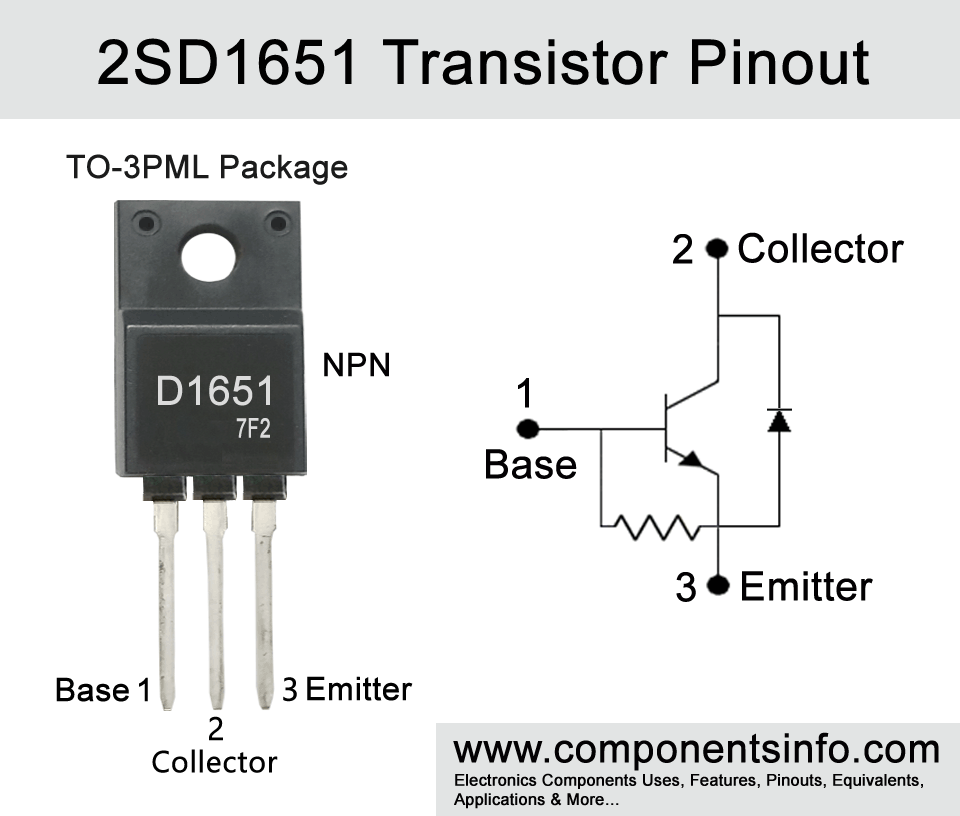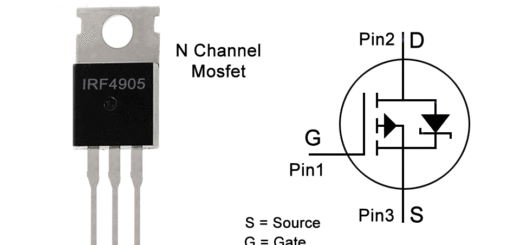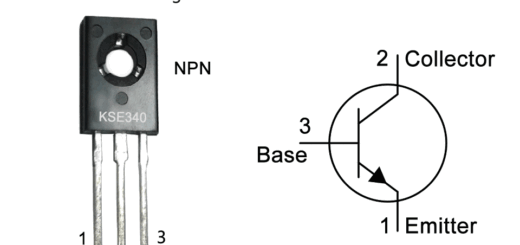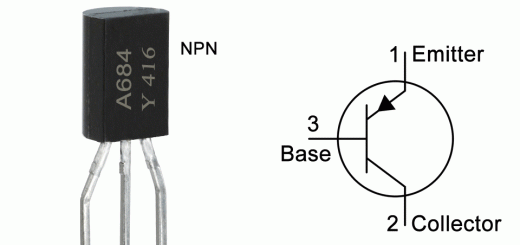D1651 Transistor Pinout, Equivalent, Uses, Features, Applications and Other Details
The D1651 is a high voltage NPN power transistor available in TO-3PML package. In this post we are going to explore the 2SD1651 transistor pinout, equivalent, uses, features, applications and other details.
Features / Technical Specifications
- Package Type: TO-3PML
- Transistor Type: NPN
- Max Collector Current (IC): 5A
- Max Collector-Emitter Voltage (VCEO): 800V
- Max Collector-Base Voltage (VCBO): 1500V
- Max Emitter-Base Voltage (VEBO): 5V
- Collector Power Dissipation (PC): 60W
- DC Current Gain (hFE): 8
- Transition Frequency(FT): 3MHz
- Max Storage and operating temperature range: -55 to 150 °C
Replacement and Equivalent
2SD1885, 2SD1881, 2SD1879, 2SD1656
D1651 Transistor Explained / Description
D1651 is a NPN power transistor available in TO-3PML package. The full part number of the transistor is 2SD1651. As looking at the image above shows the pin configuration, the first pin of the transistor is “Base” second is “Collector” and the third is “Emitter”.
This transistor is designed to be used in color TV horizontal output applications. This application or circuit is responsible for displaying the images on the TV screen stable and accurate as it is received in the signal, this becomes possible with this horizontal output circuit of the TV. What this circuit does is generate horizontal electron beams and with the help of this beam along with vertical electron beam we can see images on the color TC. But this transistor is not only limited to this single application and can be used in a variety of other applications.
Reviewing the absolute maximum ratings of the transistor the max collector-emitter voltage is 800V, max collector current is 5A, max collector-base voltage is 1500V, max emitter-base voltage is 5V and max collector power dissipation is 60W.
The transistor also has some good features which are a damper diode which is built inside the transistor connected between the emitter and collector. This diode prevents the transistor from voltage spikes. Another feature is high breakdown voltage which means this transistor can handle higher voltages without breakdown. Moreover, the transistor also has high speed switching feature means that it can switch on and off at a very high speed making it ideal to use in applications that require high speed transistors.
Where We Can Use it & How to Use
D1651 is basically designed to use in horizontal output applications of color TVs but due to its good specifications, this transistor can be used in wide variety of other applications such as switching applications. Audio amplifiers, high voltage protection circuits, voltage regulators etc.
How to Use:
- First of all check and confirm the pin configuration of the transistor.
- Secondly check pins in the design or circuit to understand which pin of the transistor will be connected to which connection.
- The emitter should be connected with the negative supply rail of the circuit and base should be connected with the signal source but it is essential to use a resistor between the signal source and the base of the transistor to ensure the transistor only get the required current, and the collector should be connected with the positive rail through a load.
Applications
Audio Power Amps
Audio amplifier circuits
DC to AC converter circuits
DC to DC converters
Voltage stabilizers
Controlling motors such as Brushed DC and Stepper
Battery management circuits
Uninterruptable power supplies
Power supply circuits
Battery charger circuits
Solar charger circuits
And variety of other applications.
Safe Operating Guidelines
Like other electronic devices, the transistor also has some limits and to safely operate it we must stay under these limits to get long term and stable performance.
- First of all, always operate the transistor under its maximum ratings and it is better to stay at least 20% below.
- A proper heatsink is also essential for good performance.
- The minimum and maximum temperature should be between -55 to 150 °C.
- As mentioned above a suitable base resistor is necessary without a base resistor the transistor could be damaged.
Datasheet
To Download the datasheet just copy and paste the below link in your browser.
https://z3d9b7u8.stackpathcdn.com/pdf-down/D/1/6/D1651-INCHANGE.pdf



